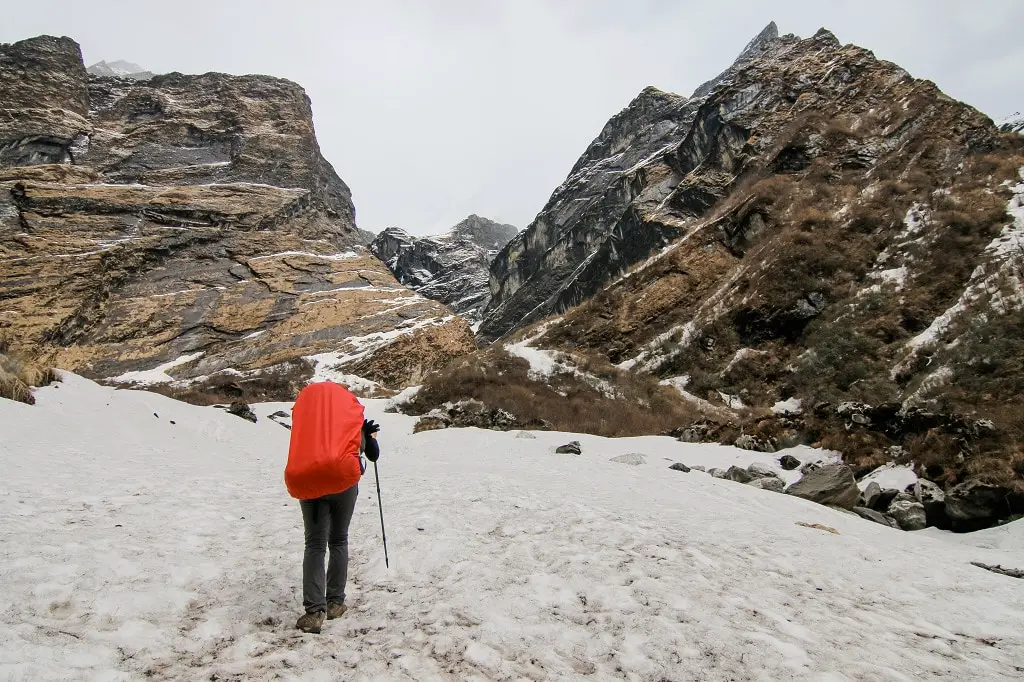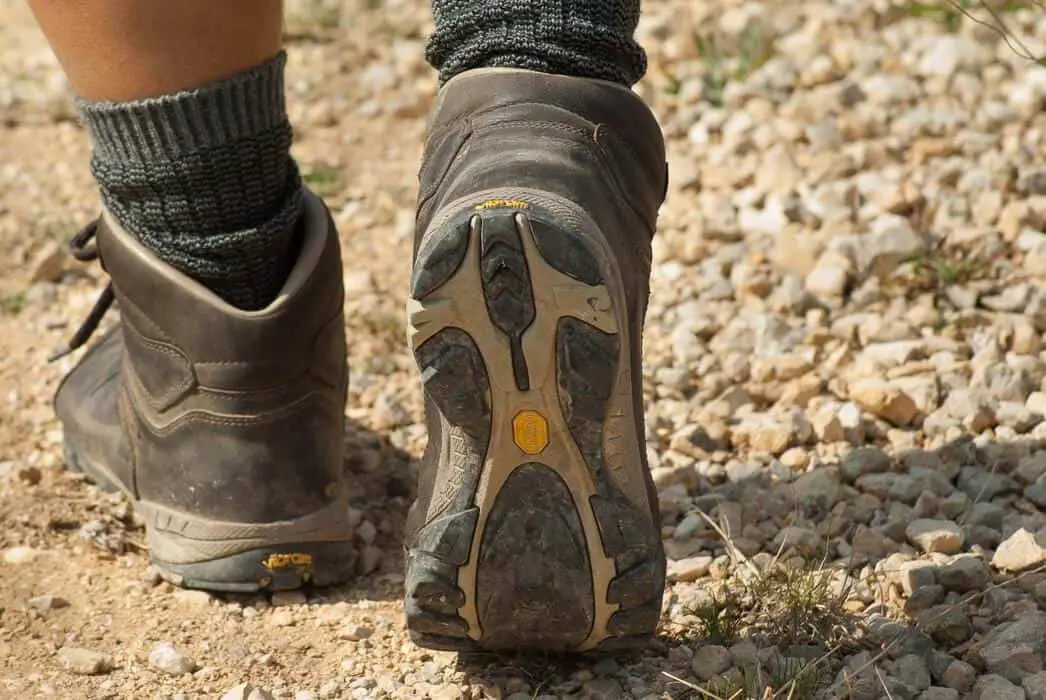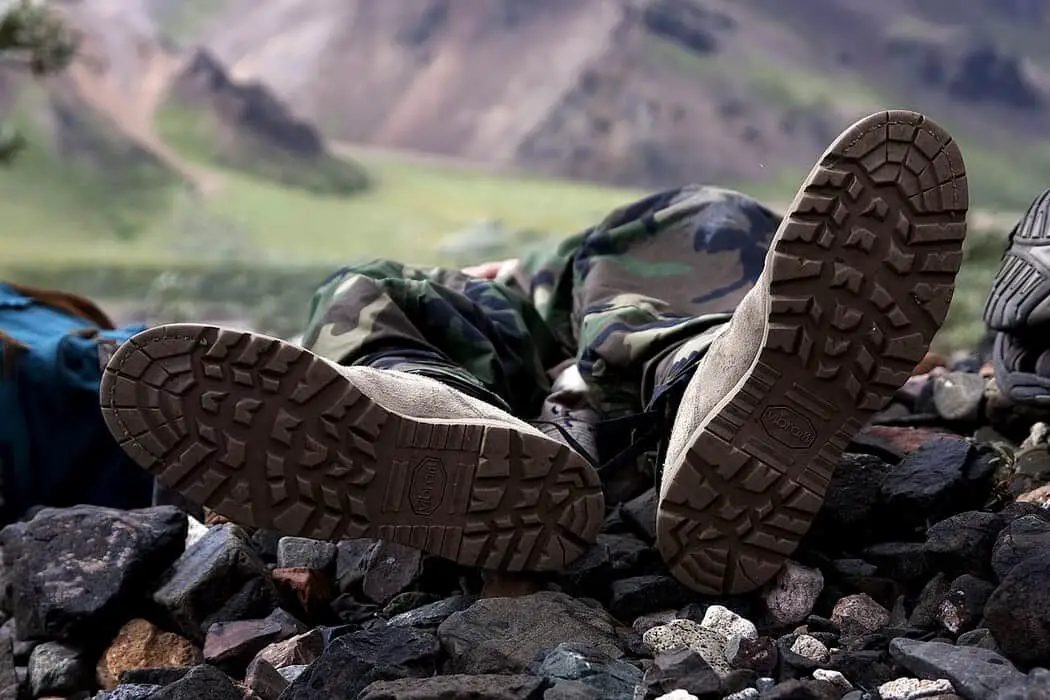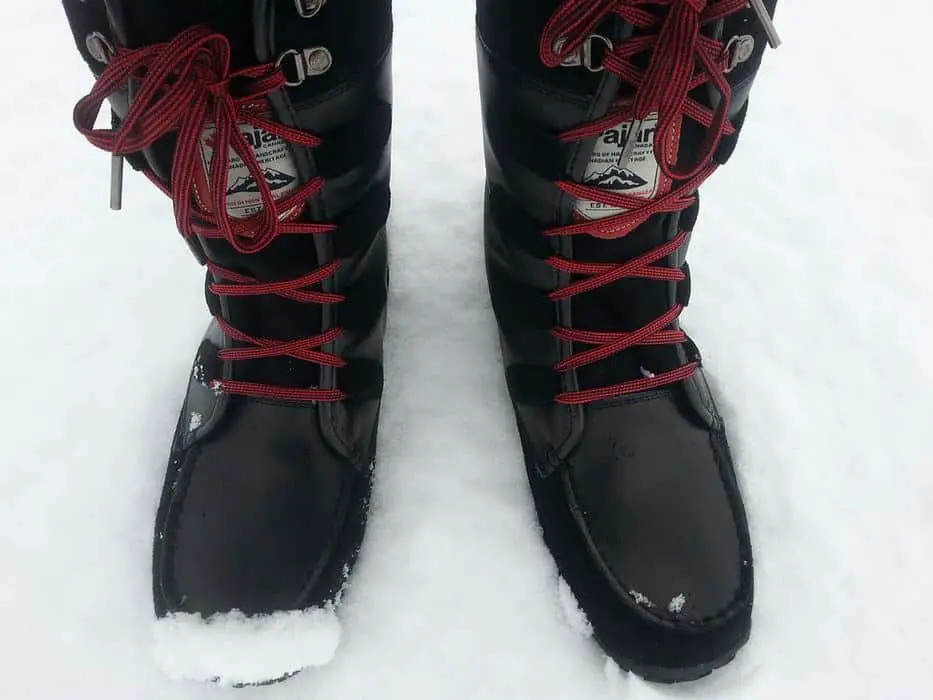My experience with hiking boots, in all kinds terrain of conditions, brought me to the obvious question – are hiking boots good for snow? I’ve been walking in the snow a lot, especially in northern Europe, and figured out which cases were suitable for boots and which weren’t.

Yes, hiking boots are good for hiking in snow – mainly for their ankle support, traction, and tread design – which are all combined together to prevent you from slipping. Also, as opposed to snow boots, they do better with long hikes, since they are more durable and supportive.
Nevertheless, in short walks, in which the snow is quite thick, perhaps snow boots would serve you better. That is mainly due to their ability to distribute body weight evenly, preventing you from sinking in.
Ankle Support
One noticeable difference between hiking boots and other footwear is their ankle support. The main reason manufacturers focus on that section is because ankles are prone to different kinds of injuries and pain.
Different kind of terrains feature rocks, hill, descents, and inclines which increase the risk of slipping and twisting your ankle.
The idea behind ankle support is to prepare you to all kinds of terrains during all fours seasons – personally, I can’t remember how many times I’ve been close to twisting my ankle during a hike.

Fortunately, that had never happened to me, yet, it could quickly end my adventure. During winter, especially when there is snow around, things tend to be a lot more slippery.
For that reason, ankle support is one essential ingredient your footwear should feature when snow hiking.
Nevertheless, you should also consider that too much support may end up with your hiking boots hurting your ankles.
Snow boots may be good at slipping prevention; however, they wouldn’t protect you too well when it had already happened.
Proper Traction
So what is traction and why is it so important? Well, traction is the main factor that allows your footwear to adjust the contact surface.
Let’s say you are hiking an incline which also features all kinds of rocks along the road. When your boots pressure the ground underneath, they do not maintain their form completely.
Our eyes won’t be able to notice this, yet, the rubber on the outsole shapes in the form of what we are stepping on. That, in turn, would provide a better grip and turn your hiking boots less slippery.
That is the main reason why plastic outsoles tend to be more slippery – plastic cannot adjust the surface underneath as easily as rubber does. When hiking in snow, that traction is more essential than ever.
While wet ground and roots tend to be slippery, it may get much worse when covered with ice. That is a subject to a whole different article; however, you probably know that from experience.
Now don’t get me wrong – snow boots usually feature a rubber outsole as well.
Nevertheless, it is not as thick as could be found with a hiking boot. The thicker the rubber is, the better traction and grip it provides.
Tread Design For a Better Grip
Hiking boots manufacturers put a lot of effort to provide the perfect outsole design.
That is mainly because the outsole is the one component that would determine your ability to walk long distances without experiencing pain or falls.
I’ve already mentioned above some factors which are related to an outsole design – traction and ankle support.
One more ingredient, which is not less important, is the tread design. If you are not familiar with the term – that is merely the grooves and spikes featured at the boot outsole.

Proper tread design is meant to provide an appropriate grip, exactly as traction does.
When you are hiking in nature, or even in a city street – the ground underneath is usually not plain or smooth – in fact, it often features tiny rocks and bumps.
That is where tread comes into action. These bumps, for example, stick inside these grooves mentioned above, so you get a better ‘sticky’ grip.
That would also be the reason a building floor is more slippery than hiking trails- there are no bumps to stick to.
Based on the same logic mentioned already – a proper grip is even more critical when it comes to snow, which is naturally more slippery.
Sufficient Water Resistance
I’m not saying other footwear products aren’t waterproof, yet, hiking boots do provide enough water resistance when it comes to snow.
While water resistance is an essential trait in wet conditions, it is even more critical while hiking on snow.
There is a common misbelief that snow doesn’t wet hiking shoes as much as water does. In fact, there are high chances it will, and in some cases even more than liquid water.
That is only because water molecules stay longer on your boots when frozen. When hiking in puddles, for example, your shoes do get wet; however, water molecules are able to vapor right away.
On the contrary, when frozen – the process is much longer since the ice should melt first.
When thinking about ice as a mass – it makes sense that the bottom layer, which touches your boots, warms faster than the upper.
That is just due to body warmth passing on. When the layer underneath begins to melt, it has merely nowhere to vapor, since the upper one is still frozen.
In that case, water molecules would try to be absorbed instead. For that reason, it is highly essential your footwear is waterproof, especially when hiking in snow.
Well, hiking boots may be impressively water resistant, especially when featuring the Gore-Tex technology.
That is another subject for an entire article, so just keep in mind that Gore-Tex is the best way to keep your footwear waterproof while maintaining breathability.
The Right Choice For Long Hikes
There is no question here – if you are planning on a long hike, which would probably feature snow – you should go with lightweight hiking boots.
Most of my hikes were done using these, and I am utterly thankful for it.
I am not saying hiking boots would prevent injuries completely – there will be blisters or in worse cases stress fractures. Nevertheless, the severity of those would be much lower when using proper footwear such as boots.
Yet, it is not that snow boots are useless, I’ve personally tried these as well – however, they do not perform well when hiking long distances.
I was starting to feel my feet rubbing against the insole only a few minutes after I’ve started walking.
That is mainly because snow boots do not have this support and snug feeling a pair of boots do.
In a case you are willing to walk a little around the city, perhaps snow boots or would serve you right. Yet, on a long hike, or even on campings – I highly suggest you choose hiking boots.
Wouldn’t Melt Snow in Your Car
I remember my trip to Switzerland when I rented a car and drove all the way from south to north. Nevertheless, not all of my journey was driving a car – I did make hikes in recommended areas along the road.
On that trip, I didn’t want to go too serious with footwear, since back in the time it seems too expensive and unnecessary.
Instead, I’ve decided to get a pair of snow boots I had back home. The little hikes I’ve made were, in general, okay, since I cannot recall and blisters.
However, as I’ve already mentioned – the hikes were short and not that serious.
Yet, I recall my car got regularly wet a while after I got inside. That was just because the boots I had accumulated tons of snow on them, which melted in my car while I was driving.
Hiking boots are not as tall, and therefore wouldn’t get that much snow in your car.
I’m not saying that’s the final factor to make a verdict, although if you consider using a car – please take this one into account.
How to Better Waterproof Hiking Boots?
As I’ve already mentioned – a Gore-Tex membrane is the one to go with when it comes to water resistance.
Its multiple layer structure was meant to provide both ventilation and water repel – to ensure dryness from both sides.
If you boots feature a Gore-Tex membrane, you don’t have to do anything more than cleaning it properly before taking off.
Nevertheless, there are other kinds of design out there, such as full-grain leathers or “rough” ones. If this is the case, there are ways to improve its water resistance performance, mainly by using wax.
First, make sure you clean your boots properly with a soft brush, leaving no trace of dirt behind. Then, when in a dry condition, only apply a thin layer of wax, using a soft towel for instance.
Which Socks to Wear in The Snow?
There are two primary considerations in socks picking when it comes to snow. First, you should face the fact that your feet are going to get wet.
No matter how water resistant your footwear is, snow will get in somewhen along the road. Second, hiking in wet socks increases the chances for blisters and infections.
For these two reasons, I recommend you get yourself a pair of thick, wool socks. These would be perfect since they provide the best thermal insulation that would serve you in wet, cold conditions.
Moreover, their full feature would keep your feet fixed, lowering the chances of rubbing the insole, which in turn, would cause blisters.
When Are Snow Boots Preferred?
Snow boots are excellent, I’ve personally used them many times. Nevertheless, they do not suit all kinds of hikes.
As already mentioned, long hikes, which perhaps would take several days to accomplish – are a big no-no for snow boots.
Besides, if the terrain is tricky, and features a lot of inclines, rocks or wet roots – stick with boots for a better grip.
On the contrary – short hikes, such as walking in the city streets, in which deep snow could be found – are better for snow boots.
The one advantage these boots hold is their ability to prevent sinking in deep piles of snow.
That is mainly due to the even weight distribution they provide, as opposed to regular hiking boots.
What Types of Snow to Consider?
In general, there are three main types in which snow may appear on your trail.
The first one would be the patchy type, where you can find snow here and there; however, most of the trail is just dirt. With this type, you would probably do just fine with hiking boots, and you don’t even have to consider snow boots or snowshoes.
The second would be fresh snow, which covers the entire ground, yet, it is not piled up. This one would be a little more slippery, so if the trail isn’t too long – I would suggest you get equipped with snow boots.
The third type, which is also the most serious, is packed snow. This one is deep so hiking boots won’t do you any good. In that case, I would suggest you get mountaineering boots, which are stiffer and suitable for deep snow. Yet, if you go with these, you should also make sure they are waterproof beforehand.
Can I Use Both?
Absolutely yes, and frankly – there is where I was heading the entire article. Both hiking boots and snow boots feature their own advantages. However, the combination of the two is the most ideal.

By doing this, you will be able to enjoy the ankle support, traction and grip the hiking boots have while maintaining the ability to walk without sinking in the deep snow.
Yet, you should make sure upfront that the snow boots are wide enough since they are going to be the outer layer.
If too narrow, wearing both may cause a severe inconvenience, followed by severe ankle/toe pains.
Conclusions
From my personal experience, hiking boots do well with snow. Since there is a significant risk of slipping – their traction, ankle support, and tread design are huge advantages.
Nevertheless, it is essential to choose a pair which features a sufficient water-resistance – perhaps Gore-Tex membrane would be the best choice.
In comparison with snow boots – hiking boots do better when it comes to long, tricky hikes since they are more durable and supportive.
In a case your boots don’t feature the Gore-Tex technology, you may improve their water resistance by applying a thin layer of wax when dried and cleaned.
On the contrary, snow boots do better when it comes to short hikes with deep snow since they prevent you from sinking.
Yet, you are entirely able to enjoy both worlds – by wearing your hiking boots inside the snow ones.

